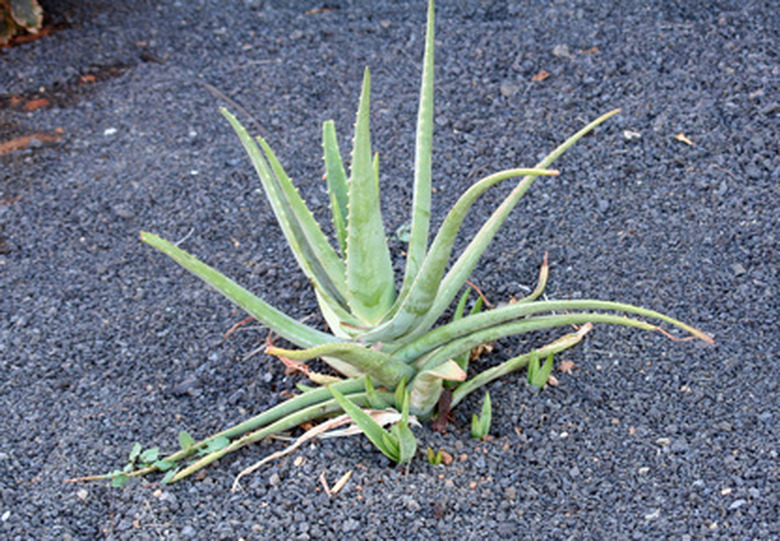Low Maintenance Tropical Plants
With a year-round growing season, landscape plants in tropical locations can require more maintenance than many homeowners have time for. Solve this by planting low-maintenance tropical plants. They will thrive with little help from you and will not grow out of control if not constantly attended to.
Perennials
A tall perennial growing up to 60 inches high, the shrimp plant (Justicia brandegeana or Beloperone guttata) produces 6-inch spikes at the tops of its stems. The spikes are red, green or rusty brown and contain small white, shrimp-like flowers. Shrimp plant grows well in full sun to full shade and is adaptable and easily grown.
Grown as a potted plant in non-tropical areas, kalanchoe (Kalanchoe blossfeldiana) grows just 1 foot high in partial shade. It is a multi-branching perennial with many succulent-like deep green leaves. The flowers are deep red, pink, yellow or orange and cylindrical in shape. They appear in late winter to early summer.
- With a year-round growing season, landscape plants in tropical locations can require more maintenance than many homeowners have time for.
- A tall perennial growing up to 60 inches high, the shrimp plant (Justicia brandegeana or Beloperone guttata) produces 6-inch spikes at the tops of its stems.
Shrubs
A medium size shrub growing 3 to 7 feet high, desert rose (Adenium obesum) produces showy flowers year-round, especially during hot, dry weather. Desert rose requires excellent drainage as it is susceptible to root rot and stem rot. An excellent shrub for rock gardens, it drops its leaves during cool weather.
Growing 2 to 4 feet high and preferring full sun, sea oxeye (Borrichia arborescens) is widely used on banks, slopes and sandy, beachfront locations. If planted in regular garden beds, ensure the soil is well-drained to prevent root rot. It produces yellow, daisy-like flowers.
Grasses
An elegant and fragrant clumping type of grass, lemongrass (Cynmbopogon citratus) has thin, strap-like leaves that are yellowish-green. When crushed between the fingers the leaves release a citrus-like aroma. Lemongrass grows 3 to 6 feet high, in full sun to light shade. Although it is moderately tolerant to drought, it prefers moist soil. Lemongrass is widely used in Asian cuisine.
- A medium size shrub growing 3 to 7 feet high, desert rose (Adenium obesum) produces showy flowers year-round, especially during hot, dry weather.
Growing 1 to 2 feet high, blue muhly grass (Muhlenbergia lindheimeri) has bluish-gray foliage and flower heads that can be purplish to gray. Although it prefers dry soil, it tolerates wet soil as long as it is in full sun. Blue muhly does well in poor, sandy soil.
Palms
A clumping palm with short stems, seashore palm (Allagoptera arnaria) grows 5 to 10 feet high in full sun to light shade. Its leaves are green on top and silver beneath. Preferring sandy soils, seashore palm is excellent for beachfront locations. Its fruit grows in a spiral on a long stalk and resembles a pineapple.
- Growing 1 to 2 feet high, blue muhly grass (Muhlenbergia lindheimeri) has bluish-gray foliage and flower heads that can be purplish to gray.
- Preferring sandy soils, seashore palm is excellent for beachfront locations.
Growing to an impressive height of 20 feet, red leaf palm (Chambeyronia macrocarpa) is named because its new leaves open a bright red to maroon color and fade to dark, glossy green. Although it prefers full sun to partial shade when mature, while young it prefers shade with well-drained soil.
Ground Covers
Used medicinally to treat burns and skin ailments, aloe vera (Aloe barbadensis) is widely grown as a potted plant in temperate areas. In tropical locations, it is a clump-forming ground cover that grows 1 to 2 feet high. Its spiked, fleshy light green leaves grow from a center rosette. Aloe vera produces flowers from winter through spring.
A prostrate succulent, hottenrot fig (Carpobrotus edulis) has long, narrow, spreading stems with erect, serrated leaves. It grows just 6 inches high and prefers full sun. Pale yellow flowers appear in spring and summer, aging to a dull pink and producing brown, fig-like fruits.
- Growing to an impressive height of 20 feet, red leaf palm (Chambeyronia macrocarpa) is named because its new leaves open a bright red to maroon color and fade to dark, glossy green.
